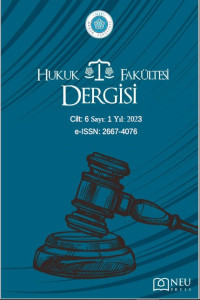Öz
Hukuk analitiği, son yıllarda gelişmekte olan bir hesaplamalı hukuk alanıdır. Temelini 1980’lerdeki bilirkişi sistemlerinden alan hukuk analitiği, zamanla matematik ile daha çok iç içe geçmiş, başta istatistik olmak üzere matematiğin çeşitli alanlarından etkilenmiştir. Son olarak da makina öğrenmesi tekniği ile bir çok problemini aşan hukuk analitiği, şimdilerde yapay zekanın gelişmekte olan araçlarını kullanmaktadır. Hukuk analitiğinin ve hukuki verinin kullanılmasının önünün açılması ile empirik hukuk çalışmaları ve hukukta sosyal ağ analizi gibi konularda hukuk çalışmalarının gündemine girmiştir. Araştırmada çeşitli hukuk felsefesi konularına değinilmiş, makina öğrenmesi ve matematiğin hukuka etkisi incelenmiş ve sonuç olarak hukuki veriler sebebiyle hukukun da veri analitiğinin ve dolayısıyla matematiğin konusu olabileceği sonucuna varılmıştır. Ayrıca hukukun kompleks sistemlerle benzerliği ortaya konulmaya çalışılmıştır.
Anahtar Kelimeler
hukuk analitiği sosyal ağ analizi makina öğrenmesi hukuki veri kompleks sistemler
Kaynakça
- Allen, Layman E. “Symbolic Logic: A Razor-Edged Tool for Drafting and Interpreting Legal Documents.” Yale Law Journal 66 (1957): 833. Alpaydin, Ethem. Machine Learning. MIT Press, 2021.
- Ashley, Kevin D. Artificial Intelligence and Legal Analytics: New Tools for Law Practice in the Digital Age. Cambridge: Cambridge University Press, 2017. https://doi.org/10.1017/9781316761380.
- Ashley, Kevin D. “Prospects for Legal Analytics: Some Approaches to Extracting More Meaning from Legal Texts.” University of Cincinnati College of Law Scholarship and Publications, 2022. http://hdl.handle.net/20.500.12424/4163495.
- Bell, Felicity. “Empirical Research in Law.” Griffith Law Review 25 (October 2, 2016): 1–21. https://doi.org/10.1080/10383441.2016.1236440. Bhat, P. Ishwara. “383Quantitative Legal Research.” In Idea and Methods of Legal Research, edited by P. Ishwara Bhat, 0. Oxford University Press, 2020. https://doi.org/10.1093/oso/9780199493098.003.0013.
- Cane, Peter, and Herbert M. Kritzer, eds. The Oxford Handbook of Empirical Legal Research. Oxford University Press, 2010. https://doi.org/10.1093/oxfordhb/9780199542475.001.0001.
- Dale, Robert. “Law and Word Order: NLP in Legal Tech.” Natural Language Engineering 25, no. 1 (2019): 211–17. https://doi.org/10.1017/S1351324918000475.
- Farrell, IP. “H.L.A. Hart and the Methodology of Jurisprudence.” Texas Law Review 84 (March 1, 2006): 983–1011. Katz, Daniel, Joshua Gubler, Jon Zelner, Michael II, Eric Provins, and Eitan Ingall. “Reproduction of Hierarchy? A Social Network Analysis of the American Law Professoriate.” Journal of Legal Education 61 (March 3, 2009).
- Katz, Daniel, and Derek Stafford. “Hustle and Flow: A Social Network Analysis of the American Federal Judiciary.” Ohio State Law J. 71 (March 1, 2008).
- Kersting, Kristian. “Machine Learning and Artificial Intelligence: Two Fellow Travelers on the Quest for Intelligent Behavior in Machines.” Frontiers in Big Data 1 (2018). https://doi.org/10.3389/fdata.2018.00006.
- Kramer, Matthew. “Hart, H. L. A.,” June 30, 2018, 1–7. https://doi.org/10.1002/9781444367072.wbiee439.pub2. Leith, Philip. “The Application of AI to Law” 2 (1988): 31–46.
- Macaulay, Tyson. “Chapter 12 - Threats and Impacts to the IoT.” In RIoT Control, edited by Tyson Macaulay, 221–78. Boston: Morgan Kaufmann, 2017. https://doi.org/10.1016/B978-0-12-419971-2.00012-1.
- Mahesh, Batta. Machine Learning Algorithms -A Review, 2019. https://doi.org/10.21275/ART20203995. Merchant, Kaiz, and Yash Pande. NLP Based Latent Semantic Analysis for Legal Text Summarization, 2018. https://doi.org/10.1109/ICACCI.2018.8554831.
- Mumcuoğlu, Emre, Ceyhun E. Öztürk, Haldun M. Ozaktas, and Aykut Koç. “Natural Language Processing in Law: Prediction of Outcomes in the Higher Courts of Turkey,” no. 58 (2021).
- Nadkarni, Prakash M, Lucila Ohno-Machado, and Wendy W Chapman. “Natural Language Processing: An Introduction.” Journal of the American Medical Informatics Association 18, no. 5 (September 1, 2011): 544–51. https://doi.org/10.1136/amiajnl-2011-000464.
- Nay, John. “Natural Language Processing and Machine Learning for Law and Policy Texts.” In Legal Informatics, edited by Daniel Martin Katz, Ron Dolin, and Michael J. Bommarito. Cambridge University Press, 2018.
- Otte, Evelien, and Ronald Rousseau. “Social Network Analysis: A Powerful Strategy, Also for the Information Sciences.” Journal of Information Science 28, no. 6 (December 1, 2002): 441–53. https://doi.org/10.1177/016555150202800601.
- Potdar, Kedar, Taher Pardawala, and Chinmay Pai. “A Comparative Study of Categorical Variable Encoding Techniques for Neural Network Classifiers.” International Journal of Computer Applications 175 (October 1, 2017): 7–9. https://doi.org/10.5120/ijca2017915495.
- Rebala, Gopinath, Ajay Ravi, and Sanjay Churiwala. An Introduction to Machine Learning, 2019. https://doi.org/10.1007/978-3-030-15729-6.
- Rissland, Edwina L., Kevin D. Ashley, and R.P. Loui. “AI and Law: A Fruitful Synergy” 150 (2003): 1–15. https://doi.org/10.1016/S0004-3702(03)00122-X.
- Sarker, Iqbal H. “Machine Learning: Algorithms, Real-World Applications and Research Directions.” SN Computer Science 2, no. 3 (March 22, 2021): 160. https://doi.org/10.1007/s42979-021-00592-x.
- Scott, John. Social Network Analysis. Fourth. 55 City Road, London, 2022. https://doi.org/10.4135/9781529716597.
- Stamper, Ronald. “The Role of Semantics in Legal Expert Systems and Legal Reasoning*.” Ratio Juris 4 (August 2, 2007): 219–44. https://doi.org/10.1111/j.1467-9337.1991.tb00094.x.
- Summers, Robert, William McRoberts, and Arthur Goodhart. “H.L.A. Hart’s the Concept of Law,” 46:1–20, 2000. https://doi.org/10.1007/978-94-015-9407-3_1.
- Susskind, Richard. “‘Expert Systems in Law: A Jurisprudential Approach to Artificial Intelligence and Legal Reasoning.’” The Modern Law Review 49 (January 18, 2011): 168–94. https://doi.org/10.1111/j.1468-2230.1986.tb01683.x.
- Teramoto, Shinto, and Paulius Jurcys. “Intermediaries, Trust and Efficiency of Communication: A Social Network Perspective,” May 26, 2013. https://doi.org/10.1007/978-3-642-41212-7_6.
- Zhong, Haoxi, Chaojun Xiao, Cunchao Tu, Tianyang Zhang, Zhiyuan Liu, and Maosong Sun. How Does NLP Benefit Legal System: A Summary of Legal Artificial Intelligence, 2020. https://doi.org/10.18653/v1/2020.acl-main.466.
Ayrıntılar
| Birincil Dil | Türkçe |
|---|---|
| Konular | Hukuk |
| Bölüm | Araştırma Makaleleri (Research Articles) |
| Yazarlar | |
| Erken Görünüm Tarihi | 7 Ocak 2023 |
| Yayımlanma Tarihi | 30 Haziran 2023 |
| Yayımlandığı Sayı | Yıl 2023 Cilt: 6 Sayı: 1 |
Bu eser Creative Commons Atıf-GayriTicari 4.0 Uluslararası Lisansı ile lisanslanmıştır.


